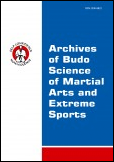2018, Volume 14, Issue 1
Judo athletes´perceptions of two training models
José Alfredo Olívio Junior1, Antonio Carlos Tavares Junior2, Aline Olívio3, Júlio Wilson Dos-Santos4, Alexandre Janotta Drigo5
1Physical Education, São Paulo State University (Unesp), Rio Claro, Brazil
2Physical Education, São Paulo State University (Unesp), Vinhedo-SP, Brazil
3Gold Kimono Project, Araras, Brazil
4Physical Education, São Paulo State University (Unesp), Bauru-SP, Brazil
5Physical Education, São Paulo State University (Unesp), Rio Claro-SP, Brazil
Author for correspondence: Antonio Carlos Tavares Junior; Physical Education, São Paulo State University (Unesp), Vinhedo-SP, Brazil; email: professorjuniortavares@hotmail.com
Full text
Abstract
Background & Study Aim: Training process planning and application is, first and foremost, the result of coach’s thinking. Subjective measures of training loads are useful tools which should be used with confidence by coaches. The aim of study was the knowledge about judo athletes’ perceptions, after two different training models, of the following indicators: motivation, pleasure, fatigue, understanding, competitive specificity, physical fitness, tactical-technical preparation, randori variability, creativity, problem-solving and general evolution.
Material & Methods: Twenty-four athletes from the U-18 (n = 14) and U-21 (n = 10) were randomly separated into two groups of 12 subjects. For two weeks, each group underwent both training models: Traditional Training (TT) and Functional Units Training (FUT). After the two weeks, an interview was conducted in order to collect athletes’ perceptions of both training models regarding each indicator.
Results: Study participants considered that FUT was more efficient in the following categories: motivation; pleasure; understanding; competitive specificity; technical-tactical preparation, randori variability; creativity; problem-solving and general evolution, while TT was perceived as superior in the other two categories analysed: fatigue and physical fitness.
Conclusions: After the two training processes, study participants considered FUT to be the most effective model for judo training.
Key words: performance, overtraining syndrome, interviews, combat sports, training loads





